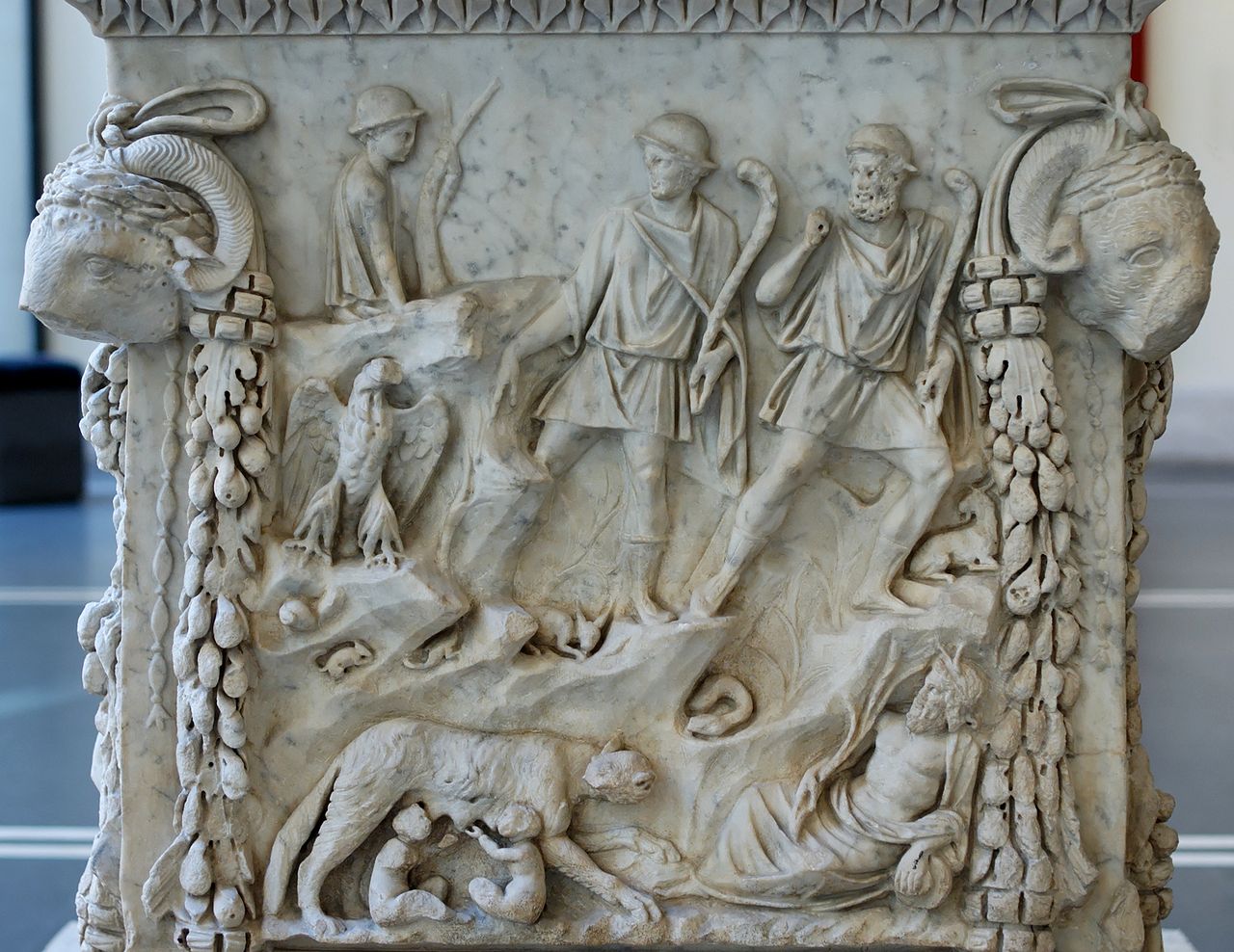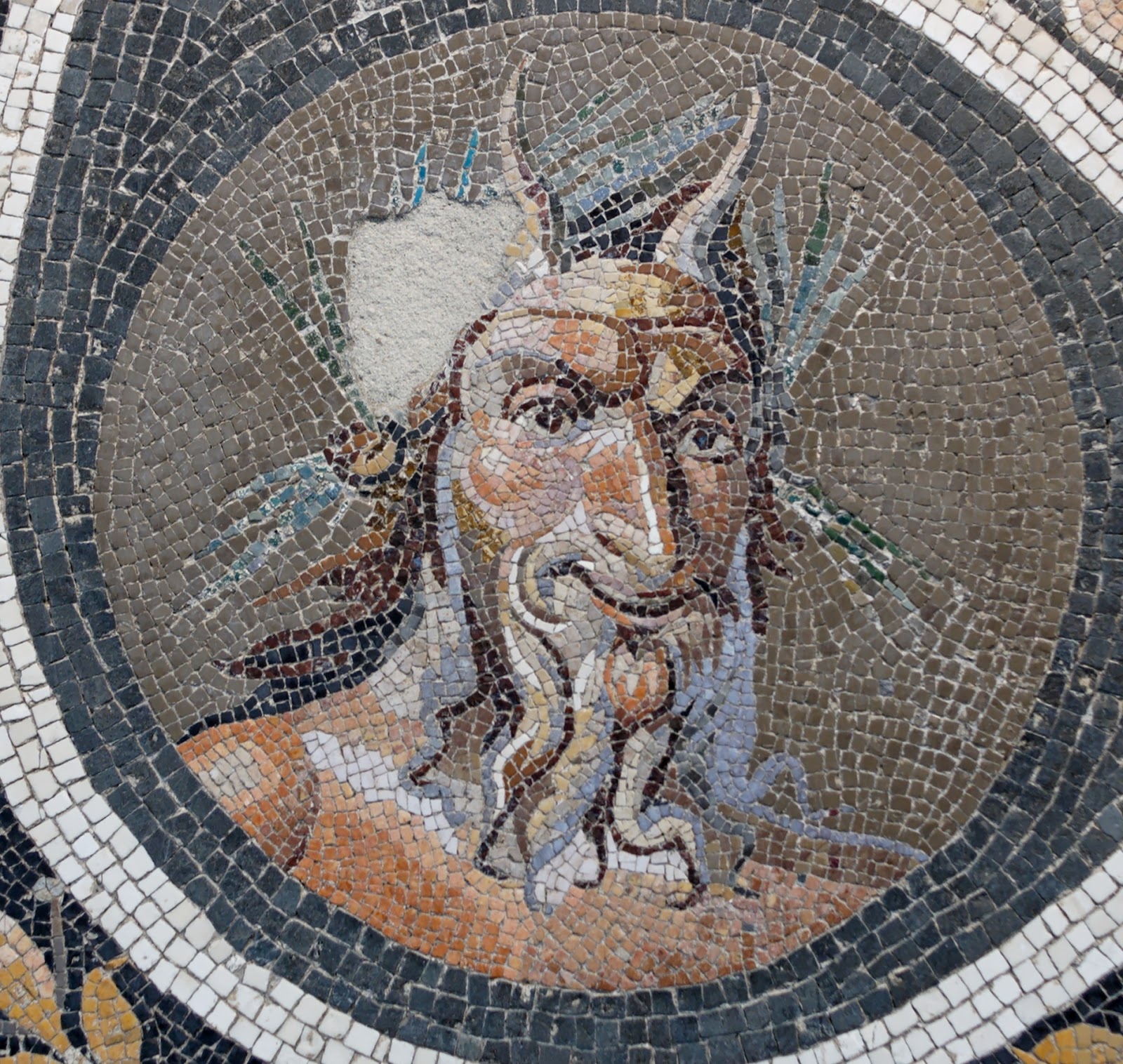by Ascanio Modena Altieri
originally published on The Dissident Intellectual
The first rays of the civilization of Rome and of the Italian national myth begin their grandiose work among the districts of the Earth. The Palatine Hill is home to the she-wolf, the nurse, savior of the divine couple of infants from the waters of the Tiber and from the evil king of Alba Longa Amulio. On the slopes of the future Colle dei Principi, with tall oaks and fabulous woods, is the Lupercale, the mythical cave, home of the fatal fair, where the blood of the prey and the milk of the breasts mix in a combination of colors that, between a few centuries, it will become an imperishable ritual and celebratory imprint. However, aids to the auspicious destiny could not be delayed: the consanguineous shepherds, Faustulus and Plistinus, found the two nobles in swaddling clothes and, with the sacred consent of the feminine beast, decided to take the two to their hut on the hill, ready one day, to tell which most dignified blood is what gushes in their veins. In the beginning it was Acca Larenzia, wife of Faustolo, who took care of the children of the God Mars and of Rhea Silvia, in the house on the Palatine, until the two appropriated, in different ways, the already marked fate.
In his Parallel Lives, more specifically of Romulus and Caesar, Plutarch tells us extensively, from the origin, up to the developments in the imperial era, what the Lupercals are and represent. Even earlier, Dionysius of Halicarnassus in his Roman antiquities tells us about the prodigious event centered on the finding of the twins and their breastfeeding.
Myth and reality, lost symbols and rediscovered artifacts, historical sources and legends, allow us to reconstruct in more detail the course of this divine event, which has become a ritual and finally a folkloristic act.
As a feast it is extremely archaic, pre-Roman on a cultural level, being able to be compared to other ancestral celebrations such as those of Hirpi Sorani - from the Sabino hirpus, or wolf - priests in charge of the cult of soranus, a Chthonic divinity venerated in a sanctuary on Monte Soratte by numerous Central Italic peoples, often united to Tinia Calusna - Infernal Jupiter - or the much better known Apollo Public chat o Suri - respectively "Black" or "From the dark place" or the kingdom of Dis - an ancient representation of the black sun. So let's see how these two divinities, already known above all in the Etruscan and Umbrian / Latin world, have been syncretized in a single initiatory cult but at the same time of a public nature, aimed at ingratiating themselves and recalling the divine powers, in view of the new year - religiously speaking, our ancestors celebrated New Year's Eve on March 1st - and in anticipation of spring just around the corner.

In fact, February was the month of purification thanks to the heavy downpours that flooded the earth, preparing it for the best seasons. Already for the Etruscans and for the Sabines, as Ovid reports abundantly in the Glories, that month had the cathartic celebration of Februa / Februatio and many other important holidays: the founding of the Temple of Juno Sospita the 1st, i Genial games 11, the Regifugium the 24 and the Equirria 27, just to name a few. These surrounded the great celebrations of the Parentalia, the nine-day festival that started from the 13th, of the foundation of the temple of Faun on the Tiber Island, to reach until the 22nd with the Charist, sealed on 23 by Terminalia, established for the first time by King Numa Pompilius in honor of the God Terminus, patron saint of the borders.
In the vast arch of the Parentalia, we also find the Quirinalia on the 17th and Feralia on 21, while i Lupercalia they were grafted in the middle of the month, between the 13th and the 15th. February he was the allegorical divinity, the one who purifies and who will then approach the Roman one February, Goddess of fevers and malaria and therefore connected to the underworld and chthonic. Catharsis therefore coincides with death and imminent rebirth, as we will see very shortly. Since the ancestral era, according to royal traditions, the ranks of wolves, held in a single group, were divided into two factions of twelve members, respectively formed by the Fabians - Fabia, one of the original tribes of Rome - and of the Quintials - Gens Quinctia, which appears for the first time in the early republican era - then joined for a short time by a third group created specifically by Gaius Julius Caesar with a perpetual dictatorship already obtained, namely the Julians - Gens Julia - according to what the great historian of the Indo-European peoples Georges Dumézil also reports [cf. Metamorphosis and ritual battles in the myth and folklore of the Eurasian populations].
The modalities of the rite provided for a complete dedication both by the direct participants and by the population of the city, therefore, the feast was celebrated in the context of nefarious dies, the days of complete detachment from judicial and more generally working activities - i dies glories they are the natural counterpart - but before moving on to the specifics it is right to remember the change of rank made for this holiday. From the beginning, up to the Divo Augusto, the direct participants in the celebrations derive, in an intuitive way, from patrician families, only from the first Emperor onwards, the young noble members were replaced by equestrians, for reasons of decorum. Always Plutarch, explains the initiatory dimension of the rite:
every year, two new luperci were selected for the groups and subsequently led into the metaphysical and spiritual dimension of the party.

On the 15th, therefore, all the participants in the rite entered the splendid and magnificently decorated Grotta della Lupa, the Lupercal temple. Beginners witnessed the sacrifice of an unspecified number of goats, probably male and a dog, as an animal closely related to the wolf and a consistent victim of the wolf, that is the veiner; shortly after it was the turn of the Vestal virgins, who burned loaves obtained with the ears of last year's harvest. While the already trained wolves skinned the dead goats and put on their skins - covering their nakedness - the two initiates received a mark, placed on the forehead by means of a knife dipped in the blood of the sacrificed animals. Once the sign was marked, it was then dried with white wool dipped in goat's milk and here, the two ancestral colors were united again, while the new luperci priests burst out in a thunderous laugh, a reaction to be traced back to birth - the liberating cry of the newborn - to in turn connected to the purifying milk of the blood, here understood as a symbol of passing away.
It is already clear, in the hermetic phase of the rite, the intention to follow the natural iter of the physical departure to the consequent metaphysical rebirth, in a purifying and renewing perspective.
Man, unable to fully understand the divine power, finds himself projected into a supernatural realm, escorted by fellow initiates, who annihilate his worldly gifts and awaken at the same time his mystical ones, giving the individual not only a memento mori, but also an awareness of the magical potential of being mortal. The priests were transmuted, similarly to the legends of the first Paleolithic Indo-European shamans, lords of portents and great connoisseurs of magic: from men, they became goats, trying to resemble God Lupercus / Faunus / Pan, keeper of sylvan secrets and protective entity of fields and crops, as well as the last true patron of the Lupercalia [cf. From Pan to the Devil: the 'demonization' and the removal of ancient European cults].
After the ritual banquet, consumed voraciously, all the priests, lightly covered by goat skins, daringly catapulted out of the cave brandishing long strips, always in goat skin, called fever o amiculum Iunonis, obtained during the flaying of animals. In a frantic tour around the Palatine Hill, following the archaic tradition of tracing the invisible sacred square around the flocks to protect them from wolves, the priests assumed a third sacred identity, that of the wolves themselves, thus becoming goat / wolf men. Honoring Pan High School, man became an animal and therefore immersed himself in a chaotic dimension but at the same time dominated by natural laws, thus becoming bulwarks and intermediaries between the real world and the magical one, the priests began the public phase of the rite. A multitude of people, especially women, came around the Palatine to watch the sacred race; in archaic times, they lent their bellies, however, in more recent times, only their hands, so that the beast priests, holders of an immense magical power, could whip them with goat whips and consequently make them fertile, like the soil that already gives some moment they were beating, with the same purpose, around the slopes of the sacred hill. Such an approach should not be surprising: the woman is assimilated to the Earth, while the man is the irrigator and fertilizer of it, everything is according to the cosmic will.
Man, in his faunal and caprine meaning, becomes animal fertilizer, while in that of wolf, apotropaic protector; thus closes the primordial celebration of telluric hierogamy for the benefit of the community, first linked to the Italic reality, then becoming all-encompassing in the Mediterranean world.
Historically, the Lupercals of 44 BC remain famous when Caesar, in a more or less predetermined way, was ritually attacked by Marco Antonio, brandishing a royal diadem. Plausibly, Caesar hoped to be crowned king during the excited celebrations by his lieutenant, however the people did not tolerate the gesture, so the great leader refused the crown served to him suddenly and in response, he offered it to the Temple of Jupiter Capitoline. As a popular festival, the Lupercals continued to be celebrated even after the idiotic Theodosian edicts - we must begin to allow ourselves to define the blatant historical indecencies for what they are - for a part of the 467th century BC once under Anttemio Procopio - Emperor of West from 472 to XNUMX - until the episcopate of Gelasius I, when in Rome, a certain senator Andromachus did not have it re-established so that the ancient divinities could appease a very serious plague that had by now decimated the urban population.
The bishop of Rome wrote a brutal and violent invective against this proposal - Adversus Andromachum senatorem - in the year 495 BCE he forbade Christian citizens to participate in the ritual. In the seventh century, so that there could be no more holds to return to celebrate the Lupercals, the Catholic Church imposed the celebration of "Candlemas" on February 2, thus covering the legacy of the festivities in honor of Juno. Suspend and February.
Today, we are capable of being able to crystallinely recognize the good from the historical and religious bad faith, for similar reasons therefore, we can only rejoice in having defeated ignorance and, in our own way, the cunning and swindling monotheism.
Mars and Venus, in Hesiod's narrative Theogony they generate that warmth, that warmth that will appear to us as Love, the anthropomorphic manifestation of the universal feeling that binds us to our indigenous traditions and to our loved ones. The rite is far from us, but not the reminder, for this, by honoring the wild and sylvan nature, we also honor the guardian spirits and their ancient priests. Instead of getting lost in useless consumerism and clownish and mocked masked idolatries, we return to love and consciously fertilize, whether it is a physical or abstract forest or an existing life or waiting to see the light, in memory of the Lupercalia festival.


6 comments on “Lupercalia: the cathartic celebrations of Februa"